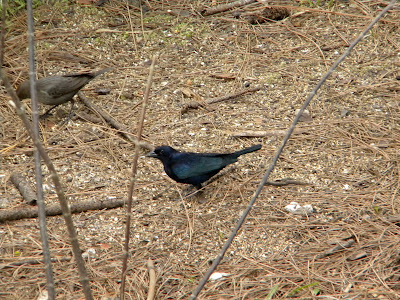

It rained thru the night and was still spitting at times at sunrise which found me driving one of those incredibly beautiful winding country roads you find here in California. Robinson Cyn is just south of Carmel, and I spent a couple of hours there looking for more new birds for the year. In particular I was hoping to scare up a California thrasher which I did, but I also found several varied thrushes just at day break, and a slew of California quail. I also had the company of a very nice rainbow and was greeted by a tom turkey.
I returned to Monterey in time to go out on a whale watching boat. The seas were a bit rough because of the weather front that had just passed thru, and it was a bit damp to start, but then we finished the trip in bright sunshine. 3 gray whales were found but not seen very much because they were feeding and the waves were not helping. Birding wise I saw some key birds including black-footed albatross, short-tailed shearwater, and pacific loon. Overall the 2+ hour trip was quite productive.
I then drove for 3 hours to the San Joaquin river delta near Sacramento in hopes of scoring a tufted duck that had been reported there. After such good fortune yesterday with the long-eared owls and mountain plovers, it was not a surprise that this time I struck out. After scanning thru all the greater scaup I saw, I came up short.
My consolation prize was stopping in Oakland at Pizzaiolo--another fine wood-fired pizza place I found 2-3 years ago. I ordered the margherita which was pretty special. The crust was classic as was the simple tomato sauce used. The fresh mozzarella had a very good flavor, and instead of basil they had sprinkled parsley and marjoram on top with a very lovely olive oil. I thoroughly savored this fine effort. I also had for dessert a flourless chocolate cake with candied orange peel and whipped cream.
The species count for the week is up to 87, and 12 more birds were added to the YTD total. Tomorrow I am taking a day off from birding to spend time with a friend here in the SF area. On Monday I will be up at Point Reyes to see what that great birding spot can deliver. Stay tuned!

























